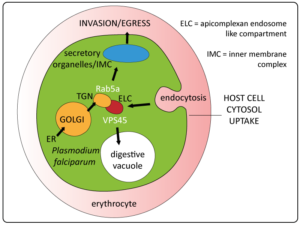P8 – Key determinants in vesicular trafficking in the human malaria parasite Plasmodium falciparum
Principal Investigators
Dr. rer. nat. Tobias Spielmann
Bernhard Nocht Institute for Tropical Medicine, Hamburg
Malaria Cell Biology

Prof. Dr. rer. nat. Tim Gilberger
Center for Structural Systems Biology, Hamburg
Cell Biology of Human Parasites

Project Summary

Malaria caused by P. falciparum is a major reason of infection related to human death. P. falciparum blood stage parasites develop within red blood cells where they divide to form new invasive merozoites in a process termed schizogony. During development to become a schizont, the parasite takes up and digests ~80% of the content of the host cell. Host cell cytosol (HCC) uptake is an endocytic process that is essential to obtain room and amino acids for parasite growth. Using novel methodology1 we identified the Sec1/Munc18-family protein PfVPS45 (in other organisms involved in vesicle fusion) as the first protein in endosomal transport of HCC to the parasite’s digestive vacuole2. In contrast, a different candidate, PfRab5a, was implicated in daughter cell formation, not HCC uptake1. Daughter cell assembly is mediated by a cascade of reorganisation processes, including the de novo genesis of parasite-specific secretory organelles and of the inner membrane complex (IMC)3, a double membrane layer underneath the plasma membrane. The genesis of these organelles depends on vesicular trafficking proteins such as Rabs. Although typically involved in endocytic trafficking, Rab5 isoforms were recently implicated in protein transport to the secretory organelles of the related apicomplexan T. gondii5. Likewise, Rab11 appears necessary for IMC biogenesis. Overall, our results with PfVPS45 and PfRab5a (not corresponding to the published TgRab5a) showcase the suspected peculiar vesicle trafficking configuration in apicomplexan parasites where many endolysosomal proteins were repurposed in a secretion pathway that intersects with endocytic transport at the trans Golgi at an endosome like compartment (ELC)5. We here propose to dissect these two fundamental pathways.
In these projects we propose to disentangle endosomal HCC trafficking from that in daughter cell assembly using proteins involved in these two processes. In the first project (PhD1/Spielmann), the first protein identified in HCC transport (PfVPS45) will be used as a stepping stone to unravel endosomal transport. In the second, closely connected project (PhD2/Gilberger), the function of PfRab5a and PfRab11 in daughter cell formation will be assessed, focusing on the endosomal compartments, the secretory organelles, and the IMC. This work will elucidate the molecular basis for the vesicular trafficking of key processes of malaria blood stage parasites and shed light on the connection of these trafficking routes.
References
1. (2017) A genetic system to study Plasmodium falciparum protein function. Nat Methods 14:450-6. Abstract
2. (2019) PfVPS45 Is Required for Host Cell Cytosol Uptake by Malaria Blood Stage Parasites. Cell Host Microbe 25:166-173.e5. Abstract
(2016) Pellicle formation in the malaria parasite. J Cell Sci 129:673-80. Abstract
4. (2013) An overexpression screen of Toxoplasma gondii Rab-GTPases reveals distinct transport routes to the micronemes. PLoS Pathog 9:e1003213. Abstract
(2018) Intersection of endocytic and exocytic systems in Toxoplasma gondii. Traffic 19:336-53. Abstract
